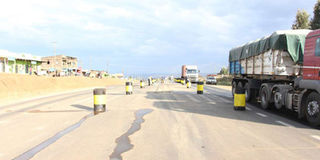How the highway ‘spirits’ of Sachang’wan were finally tamed

Constructions takes place on Nakuru-Eldoret highway in Salgaa and Sachang'wan areas as part of efforts to curb deadly accidents, March 23, 2019. PHOTO | PETER MBURU | NATION MEDIA GROUP
What you need to know:
- Among the superstitious beliefs traditional leaders held was that the spirits of the 200 Sachang’wan 2009 fire tragedy victims buried in a mass grave nearby were hovering around, baying for blood.
- But even after several meetings, elders failed to come up with a solution, shrugging off the superstitions and choosing to stick with what the authorities were saying; that the accidents were caused by carelessness.
- Most accidents, according to Molo police base commander Moses Nderitu, resulted from truck drivers losing control after free-wheeling.
Two days after 21 people were crushed to death when a lorry rammed several vehicles at Sachang’wan on the Nakuru–Eldoret Highway, on December 12, 2017, traditional leaders met.
They had had enough. That month alone, close to 150 people had died in the area, several had been injured, and the leaders from the Kalenjin community had decided to meet and find a solution to the problem.
Among the superstitious beliefs they held was that the spirits of the 200 Sachang’wan 2009 fire tragedy victims buried in a mass grave nearby were hovering around, baying for blood.
The elders even dug into their history and came up with a claim that the spirits of three cursed Nandi chiefs who died near Sachang’wan were causing the accidents on the Kibunja- Salgaa stretch.
But even after several meetings, the elders failed to come up with a solution, shrugging off the superstitions and choosing to stick with what the authorities were saying; that the accidents were caused by carelessness.
MITIGATION
Some 230 kilometres away, other consultative meetings were ongoing between the Ministry of Transport, the National Transport and Safety Authority(NTSA) and the Kenya National Highways Authority (KeNHA).
On April 24, 2018, KeNHA contracted China Railway Number 10 company to start transforming the road into a dual carriageway.
Since then, police, residents and authorities say no major accident has occurred in the area.
“We used to be called almost every night to either rescue people or help pull a car out of a ditch,” a resident, Paul Mugire, said.
He said the splitting of the road, erection of bumps and marking of the road stretches had eliminated mass deaths.
More police road blocks in the area, he said, had also helped reduce the number accidents.
FREE-WHEELING
Most accidents, according to Molo police base commander Moses Nderitu, resulted from truck drivers losing control after free-wheeling.
“Most truck drivers have been notorious for fuel siphoning and so they always engage the free gear so that they recover the fuel sold. Most of them used the wrong lane and in the process collided oncoming vehicles,” Mr Nderitu said, adding that with the erection of the New Jersey wall, head-on collisions had completely been eliminated.
The construction works involved widening and surface dressing on the 11.5-kilometres climbing lane to provide four lanes each from Molo River to Kibunja and separation using a wall.
KeNHA also marked the 26.5 kilometres between Sobea, commonly known as the Kabarak junction, and Kibunja and the construction of speed bumps and rumble strips on parts of the stretch.
KeNHA Corridor B director Samson Murage said the authority was in the process of constructing lorry brakes’ checking points and a holding yard with a minimum holding capacity of 20 heavy goods’ vehicles at Kibunja.
This, he said, would help check the vehicles and give drivers a chance to rest.
“Expansion of the carriageway and erection of the Jersey barriers have been complete except for 800m at the GSU Molo camp, and road markings have been done at the Kabarak Junction and the Molo River,” Mr Murage said.
ROAD WORK
Mr Murage added that the procurement process was ongoing for the planned construction of the Rironi-Mau Summit stretch.
He said that a contractor had already been identified and would begin working on the road next year.
“We were first concentrating on the critical sections of the road, with the aim of urgently reducing the road crashes,” Engineer Murage said.
The project is funded by the government through the Road Maintenance Levy Fund.
Residents of Nakuru called on KeNHA to also do something about the Kikopey stretch where 12 people died when a truck and a 2NK shuttle collided head-on.





